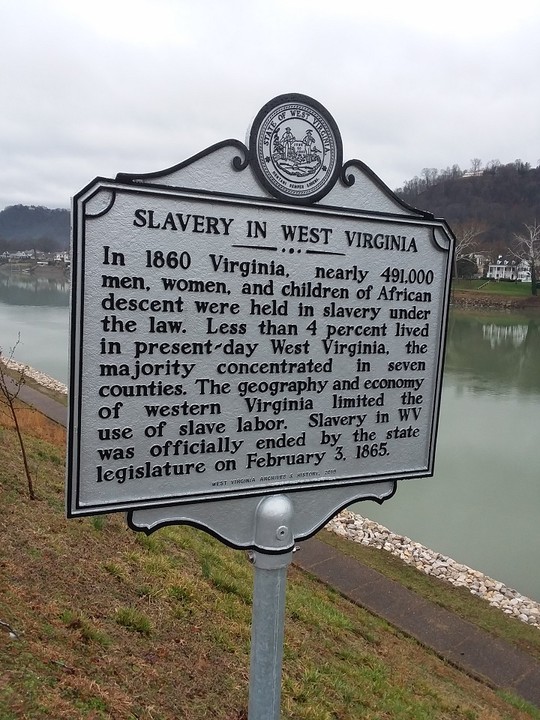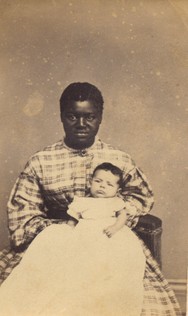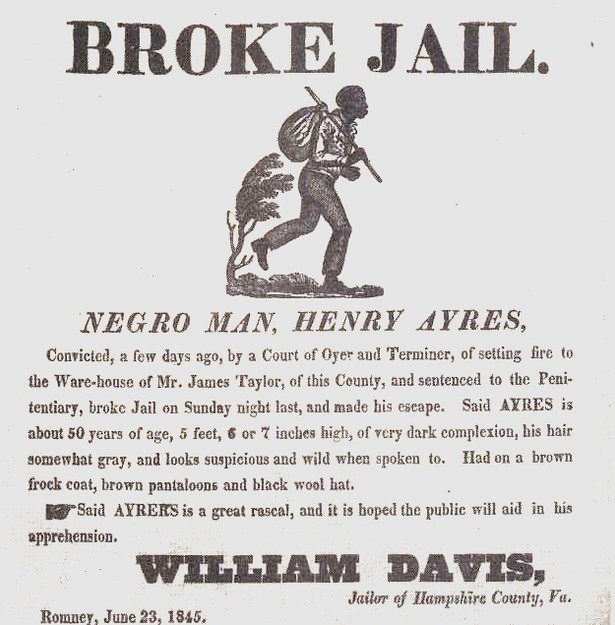Slavery in West Virginia Highway Historical Marker
Introduction
Text-to-speech Audio
Images
Slavery in West Virginia Highway Historical Marker

Photograph of "Aunt Susan" and unknown infant taken in Wheeling in April 1865

A runaway slave advertisement from Hampshire County (1845)

Backstory and Context
Text-to-speech Audio
By the Civil War, there were just under four million enslaved African Americans living in the South. Virginia had an enslaved population of nearly 500,000, the largest enslaved population of any southern state at the time. In the western Virginia counties that would eventually become the state of West Virginia, enslaved African Americans were much less prevalent than in counties in the eastern part of the commonwealth. In 1850, the future state of West Virginia contained roughly 20,500 enslaved African Americans, which constituted just under seven percent of the total population. By the Civil War, these numbers had declined slightly.
In western Virginia on the eve of the Civil War, the enslaved African American population was focused largely in four areas. The Shenandoah Valley counties of Berkeley and Jefferson boasted a total enslaved African American population of just over 5,600. Berkley County, in fact, had not only the largest number of enslaved African Americans of any western Virginia county (nearly 4,000), but also the highest proportion of enslaved persons to overall population (about twenty-eight percent). The Kanawha Valley counties of Kanawha and Putnam possessed almost 2,800 enslaved African Americans, while the South Branch Valley counties of Hampshire and Hardy contained nearly 2,300. Finally, in Greenbrier County, just over 1,500 African Americans were held in bondage.
While the number of enslaved African Americans in other parts of the South dwarfed the number of enslaved African Americans in western Virginia, slavery was still incredibly important to the economy of western Virginia. Enslaved African Americans labored in a variety of occupations and settings. They worked as kettle-tenders, miners, packers, teamsters, and general laborers in the saltworks and coal mines of the Kanawha Valley. In the Shenandoah, South Branch, and Greenbrier valleys, enslaved African Americans toiled as field hands on large wheat plantations. Throughout western Virginia, they could also be found working as field hands on small family farms, as general laborers on public works projects, and as domestic servants in wealthy households.
The onset of the Civil War and the West Virginia statehood movement precipitated the end of slavery in western Virginia. Early in the conflict, federal armies invaded and controlled large swaths of western Virginia. When Union forces neared, enslaved African Americans emancipated themselves by fleeing to federal lines. Some were sent to contraband camps, while others congregated in cities and towns. Many provided labor for the Union war effort. When President Abraham Lincoln’s Emancipation Proclamation went into effect on January 1, 1863, it only declared enslaved African Americans residing in the Confederacy to be free. When West Virginia officially became a state later that same year, the state constitution only called for gradual emancipation. Finally, in February 1865, the West Virginia legislature officially abolished slavery in the state.
In 2018, as part of its Civil War sesquicentennial project, the West Virginia Highway Historical Marker Program of the West Virginia Archives and History installed a marker to acknowledge the existence of slavery in what eventually became the Mountain State. It stands along Kanawha Boulevard East in Charleston.
Sources
Graham, Henry S. and Edwin Hergesheimer. "Map of Virginia: Showing the Distribution of Its Slave Population from the Census of 1860." Library of Congress. Web. 06 September 2020 <https://www.loc.gov/item/2010586922/>.
Stealey III, John Edmund "Slavery." e-WV: The West Virginia Encyclopedia. 29 October 2010. Web. 06 September 2020 <https://www.wvencyclopedia.org/articles/456>.
http://www.wvculture.org/history/markers/sesqui/slaveryinwestvirginia.html
https://en.wikipedia.org/wiki/History_of_slavery_in_West_Virginia
https://en.wikipedia.org/wiki/History_of_slavery_in_West_Virginia
